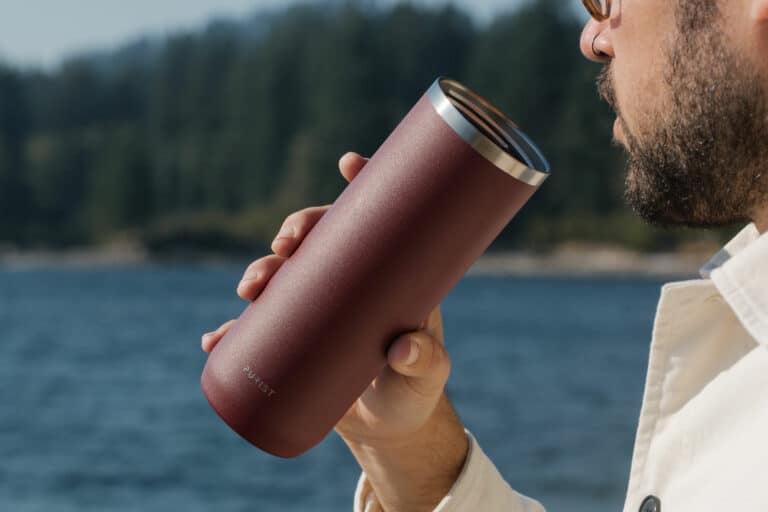Bruce Edmonds has managed the recycling program of Virginia’s Rivanna Solid Waste Authority for the past 15 years. Servicing the city of Charlottesville and neighboring Albemarle County, it’s been called one of the best programs in the region for efficiency and volume of recycled products. We asked Edmonds to set the record straight on some of the myths and truths of recycling.
DO I NEED TO TAKE THE LABELS OFF JARS AND CANS?
No. They will be burned off during the recycling process.
CAN PLASTIC BAGS BE RECYCLED WITH PLASTIC CONTAINERS?
No. Most plastic bags can be accepted separately if you’re willing to take them to a drop-off location. Make it part of Saturday errand-hopping so you’re not spewing carbon emissions solely to recycle your bags. To find plastic bag drop-off sites in your area, go to plasticbagrecycling.org.
HOW CLEAN DO CONTAINERS NEED TO BE BEFORE I TOSS THEM INTO THE RECYCLING BIN?
A good rinse will suffice; a little residue at the top of a bottle is fine. Just try to remove all food bits.
ARE ALL RECYCLED PRODUCTS TURNED BACK INTO THEIR ORIGINAL FORM?
Not necessarily. Aluminum cans will usually become aluminum cans again. Here in Charlottesville, recycled glass is turned into a substitute for gravel. The substitution saved the county $25,000 on road expenses last year. In the case of paper, the quality of the recycled paper fibers is assessed at the mill. The higher-quality fibers are used to create more recycled paper, while the shorter, lower-quality fibers are turned into things like toilet paper, paper towels, and cereal boxes.
HOW MUCH ARE RECYCLED PAPER PRODUCTS ACTUALLY WORTH?
Corrugated cardboard almost always has a good market for it—between $50-100 per ton. Newspaper is a different story and the price paid ranges from $0 to $30/ton (that is after collection and processing.) Since it may cost $50 a ton to collect and process newspaper, some people may say it is not worth it if you can only sell it for $25 per ton. However, throwing it away is not free. It cost an average of $50 to collect and dispose of trash. If you enter that into the equation, it costs less to recycle.
IS RECYCLING COSTING ME A LOT OF MONEY AS A TAXPAYER?
No. The annual budget for servicing Charlottesville and all of adjoining Albemarle County is $600,000, and we were able to retrieve half of that amount by selling recycled products to contractors.
Most city curbside recycling programs cost residents about $30 per year. That fee provides jobs and protects resources that often aren’t calculated on the balance sheet. And the more people who participate in curbside recycling, the more efficient and cost-effective it becomes.
WHAT DO THE DIFFERENT NUMBERS ON PLASTICS STAND FOR?
They refer to content of material, a resin guide for recycling purposes. Each number and abbreviation represents a plastic grade. All plastics are made from petrochemicals. Only #1 and #2 plastics are recyclable in most areas: #3, 4, 5, 6, and 7 plastics are not recyclable in most places.
WHY CAN’T ALL PLASTICS BE RECYCLED?
It comes down to demand. Markets for recycling plastics are limited when they can’t be used for common items like juice containers, milk jug, or soda bottles (#1 and #2).
CAN I RECYCLE MY COMPACT FLUORESCENT LIGHT BULBS?
Yes, they need to be recycled properly—and separately—because they contain small amounts of toxic mercury. Don’t throw them away with regular garbage, because they pose a health risk to sanitation workers and eventually others if they end up in a landfill.
SHOULD I STEP ON PLASTIC BOTTLES AND CRUSH CANS?
Yes, if possible. They will be crushed anyway, so it helps speed the process along.
IF A GLASS OR PLASTIC PRODUCT DOESN’T HAVE A RECYCLING LOGO ON IT, CAN IT STILL BE RECYCLED?
Glass, yes. Plastic, no.
CAN ALUMINUM FOIL BE RECYCLED WITH CANS?
Technically it can, but not all recycling programs accept it because of food contamination.
IF I PUT THE WRONG NUMBER OF PLASTIC IN MY BIN, WILL IT RUIN THE WHOLE BATCH?
Usually not, but it makes more work for sorters, so we ask the public to do the right thing.
—————
CRADLE TO CRADLE:
ALUMINUM CANS
Next time you finish that can of suds, make sure it ends up in the recycling bin. It may be a cliché token act of environmental conscience for most people, but when it comes to aluminum, recycling makes a big difference. Your favorite brew or soda porter can be reincarnated in as little as 60 days, and it requires 95 percent less energy to recycle a can than it would to create a new one out of virgin ore. Recycling aluminum cans is a closed-loop process; cans can be recycled an infinite amount of times—unlike certain kinds of paper, which can lose quality after being washed and reprocessed. But aluminum just keeps going, and within two months of being recycled, it is crushed, shredded, melted, rolled into sheets, and reformed back into new cans that are ready for resale.
Cans also don’t have to travel too far to be processed. When someone recycles a can at the McIntire Recycling Center in Charlottesville, Va., it is first driven just over a mile to Coiners Scrap Iron and Metal. The cans are then placed in an industrial compactor and crunched into 35-pound bricks, which are then stacked into bundles of 100. Coiner’s then sells its cans through Anheuser-Busch Recycling. According to the company’s business development manager Tim McAllister, the cans from Central Virginia will be shipped to a Novelis processing plant, most likely in Greensboro, Ga., or Berea, Ky., where they will be melted and turned into rolled sheets of aluminum. Aluminum processed in Greensboro will usually be shaped and filled with Budweiser less than 150 miles away at Anheuser-Busch’s facility in Rome, Ga.
Because of the efficiency of recycling aluminum, it has amounted to big business. “The bulk of recycling is done for money,” says Coiners owner Preston Coiners, who ships out more than one million pounds of cans every year. In that time Anheuser-Busch buys 27 billion recycled cans.
—————
RECYCLING: BY THE NUMBERS
1 Aluminum can recycled saves enough energy to run a TV for three hours.
2 Months it takes one can to be turned into another can.
52 Total percent of aluminum cans recycled every year.
100 Watt light bulb that can run for four hours from recycling a glass bottle.
380 Average number of drinks in aluminum consumed by each American per year.
4000 Years it takes a glass bottle to decompose.
105,784 Cans are recycled every minute nationwide.
2,500,000 Plastic bottles used every hour in the U.S.
18,700,000 Tons of aluminum recycled since 1972.
250,000,000 Trees saved each year if every newspaper was recycled.
1,000,000,000 Trees worth of paper thrown away every year in the U.S.
1,000,000,000 Dollars earned per year by Americans by recycling aluminum cans.
500,000 Trees cut down to produce Sunday’s newspaper.
25,000,000,000 Styrofoam coffee cups thrown away every year in America.







